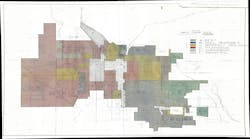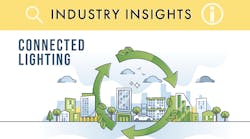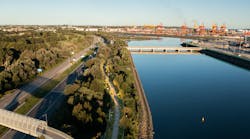OUTDOOR LIGHTING | Light done right transforms public spaces
When the weather cooperates, communities anticipate a surge in outdoor activities. From evening strolls in the park to late-night gatherings at local eateries, a vibrant energy brings people together in shared spaces. With increased activity comes the heightened need for ensuring public safety. Among the myriad factors that contribute to a secure and welcoming environment, one critical aspect stands out: proper lighting.
Effective lighting does more than just illuminate—it transforms environments. Well-placed, high-quality lighting enhances visibility, making it easier for pedestrians and motorists to navigate their surroundings. It can also act as a potential deterrent to criminal activity, creating well-lit areas with improved visibility and therefore more activity.
Thoughtfully designed lighting schemes can foster a sense of community, encourage social interactions, and boost the local economy by making streets, pedestrian plazas, and parks more inviting after dark.
In this article, we’ll explore how LED technology can enhance safety, review key considerations for lighting design and planning, and highlight examples where modern lighting is making a difference.
Urban illumination evolves with LEDs
LED lighting has transformed urban illumination through its energy efficiency, longevity, and performance advantages over traditional lighting. These lights use much less power, leading to significant savings on energy bills and a lower carbon footprint. With a longer lifespan, LEDs reduce the need for frequent replacements, cutting costs. Furthermore, LEDs deliver focused, high-CRI light that enhances visibility for both pedestrians and drivers, reducing accident risks and improving overall safety.
However, the process of integrating these solutions into urban landscapes takes careful planning. Cooperation between lighting design professionals and urban planners is pivotal to ensuring that solutions are effective and tailored to the specific needs of different community zones. From residential areas with a focus on subtler, comforting illumination to bustling commercial districts requiring brighter, more dynamic lighting, each environment requires careful assessment and collaboration with community stakeholders.
For instance, residential ordinances often mandate lower light levels and shielded fixtures to minimize light trespass and protect residents’ privacy, while commercial regulations may allow higher illuminance but require extensive measures to prevent spillover into adjacent properties.
Lighting considerations for community zones
Although local ordinances have detailed planning for various community zones, the following guidelines can assist lighting designers and urban planners in creating environments that meet regulatory standards while enhancing the satisfaction of local residents. These zones typically require lower light levels to minimize spillover and avoid disturbing residents.
Residential areas
Color temperature: Warm white lighting (around 2700K to 3000K) is preferred to create a cozy, welcoming atmosphere while reducing blue light emissions.
Light placement: Focus on illuminating pathways, entryways, and communal spaces with shielded fixtures to direct light downward and minimize spillover.
Aesthetic integration: Choose lighting fixtures that complement the architectural and landscape design of the residential area. Well-integrated lighting can enhance the visual appeal and cohesion of the space, creating a more inviting atmosphere.
Commercial districts
Higher illuminance: Balance safety and ambience by choosing color temperatures that suit the area’s character. For example, use cooler white light (4000K with a higher basic CRI) in high-activity zones to promote alertness and warmer tones (3000K) in leisure areas for a relaxed atmosphere.
Uniformity: Ensuring consistent light distribution is crucial to avoid dark spots and improve the overall aesthetic appeal. This involves careful planning of fixture placement and selection of lights with appropriate beam angles. It’s also essential to plan for the relationship between the lighting and the site’s foliage growth over time.
Adaptive lighting: Implement smart lighting systems that adjust brightness based on pedestrian activity, business hours, and natural light availability to balance energy efficiency and security.
Shielding: Glare prevention and managing direct uplight are equally crucial in commercial environments to prevent light from affecting areas outside the intended illuminated space.
Solving streetlighting challenges
Extensive streetlighting projects require substantial funding and resources, which can pose financial challenges for city governments operating under tight budgets. Investing in energy-efficient LED lighting can lead to long-term cost savings in operating and maintenance expenses. Furthermore, properly designed fixtures with adequate shielding can reduce glare and prevent light from spilling into unintended areas, enhancing overall comfort and safety.
By addressing these challenges with thoughtful design and strategic implementation, cities can capitalize on the benefits of LED street lighting, including a significant reduction in energy usage by up to 50% to 70% compared to traditional options. For example, when the City of Los Angeles retrofitted over 140,000 streetlights with LEDs, it achieved an annual energy savings of approximately $10 million.
LEDs’ longer lifespan—typically lasting 25,000 to 50,000 hours—translates to lower maintenance costs, as the frequency of lamp replacements decreases significantly. For instance, the City of Seattle reported that its LED streetlights have a projected lifespan of 12 to 15 years, compared to the average four to six years for high-pressure sodium lights.
Additionally, LEDs offer improved control over light distribution and intensity, allowing for precise adjustments that cater to specific urban needs. Appropriate optics for beam distribution and shielded fixtures that direct light downward are crucial in minimizing light pollution. These fixtures ensure that light is concentrated on streets and sidewalks rather than spilling into residential areas or the night sky. When the city of Tucson, Ariz. adopted shielded LED streetlights, it reported a 7% reduction in skyglow that improved visibility for pedestrians and drivers.
Moreover, strategic positioning of lighting fixtures plays a key role in reducing light spill. By carefully planning and adjusting the placement of luminaires to focus illumination only where it is needed—such as on pathways, entrances, and intersections—cities can enhance security without overwhelming the surrounding area. This approach not only preserves the natural night environment but also contributes to the overall aesthetic and functional quality of the space. Implementing controls and sensors can further optimize energy usage, ensuring that lights operate at full intensity only when necessary.
These examples illustrate how adopting LED lighting solutions can lead to operational savings, reduced environmental impact, and improved urban living conditions.
Lighting’s impact on public safety
Many researchers have examined the role of streetlighting in enhancing public safety. Although some studies suggest that new outdoor lighting can reduce crime rates, the evidence is not conclusive. A comprehensive review indicated a link between new lighting and reduced crime, but the improvements were noted in both daylight and darkness, implying that factors other than streetlighting play a role.
Regardless of its impact on crime, streetlighting undoubtedly influences how safe people feel while walking at night. Brighter lighting levels can increase the amount of time people spend walking weekly, reduce the number of people avoiding nighttime outings, and foster a sense of community pride. Improved lighting can also mitigate social isolation to enhance physical and mental wellbeing.
Note that “streetlighting” is often used as a catchall phrase for what is really a combination of streetlighting, pedestrian (sidewalk) lighting, and community lighting. Although commonly related and delivered by the same system, these types of lighting are not necessarily the same; they are often confounded in their application and effect because they are not generally independently controllable. Proper differentiation and control of these lighting types could lead to more targeted and effective lighting solutions.
At the same time, excessive lighting is not advisable. The University of Sheffield’s lighting research group conducted studies aimed at better understanding how lighting affects feelings of reassurance after dark. In one experiment, participants walked along various streets at night and rated their sense of safety. They also rated these streets during the day. The research found that while increasing the average illuminance (the amount of light falling on a surface) was linked to improved feelings of safety, the uniformity of lighting (how evenly the light is distributed) was even more critical. Therefore, evenly spread lighting may be more effective in making people feel safe than simply increasing brightness.
As local authorities replace traditional high-pressure sodium lamps with LED lights, they also gain greater control over lighting, such as the ability to dim lights to conserve energy when no pedestrians are present. This flexibility can help address the nuanced needs of street lighting, pedestrian lighting, and community lighting, ensuring that each type serves its intended purpose effectively without contributing to wasted light and energy consumption.
Balancing dark sky requirements
As lighting designers and urban planners strive to enhance nighttime environments, the challenge of adhering to “dark sky’ requirements also becomes critical. DarkSky International advocates for reducing light pollution through smart lighting solutions, recommending practices such as minimizing blue light emissions, using shielded fixtures to direct light downward, and incorporating smart controls like dimmers, timers, and motion sensors. These strategies not only protect the night sky but also promote efficient and effective urban lighting.
Imagine “City Z,” where the integration of dark-sky-compliant LED fixtures demonstrates how this balance can be achieved. Adaptive lighting controls allow the community to dim lights during low-traffic hours, reducing energy consumption and light pollution. This approach meets environmental standards while helping to ensure that public spaces remain safe and inviting.
The adaptive controls dynamically adjust brightness based on real-time activity, increasing illumination during high-traffic periods and dimming during quieter times. Additionally, the uniform lighting prevents dark spots, enhancing safety for pedestrians and drivers. This design further complements the community’s aesthetics, and public awareness campaigns educate residents about the benefits of dark-sky compliance, fostering support.
By following DarkSky International guidelines and using advanced lighting controls, communities can reduce light pollution, enhance perceptions of public safety, and achieve economic benefits. Balancing environmental standards with safety needs is attainable through thoughtful design and the integration of smart technologies.
An enlightened future
Innovative lighting solutions play a crucial role in protecting our communities. By embracing LED technology, implementing and adhering to modern lighting standards, and incorporating smart design features, lighting professionals and urban planners can create safer, more vibrant public spaces. The positive impact on safety, energy efficiency, and community wellbeing makes these solutions invaluable for modern urban environments.
Furthermore, the integration of advanced lighting systems goes beyond mere illumination. It can create environments that encourage social interaction, foster economic development, and promote a sense of community. By thoughtfully designing lighting that adapts to different urban zones and respects environmental considerations, we can build safe, sustainable cities. Lighting professionals and urban planners are encouraged to consider these strategies in their projects, balancing the need for safety with environmental considerations.
REFERENCE
- “Evolve Streetlights Brighten Up the City of Toledo,” Current project spotlight.
Alex Price
ALEX PRICE is brand & planning manager at Current Lighting. Price joined Current in 2015, after interning with the GE Lighting organization while he earned his BFA in industrial design from Cleveland Institute of Art.
Current is Always On and working to improve lives with the industry’s most expansive portfolio of sustainable advanced lighting and intelligent controls that reliably meet customers’ needs. Learn more at currentlighting.com.
Gary Steinberg, LC MIES
GARY STEINBERG is senior system manager (outdoor LED fixtures) at Current Lighting. Leveraging decades of experience in electro-optics systems design, luminaire optical system design, photometric design, and optical testing and engineering management, Steinberg has served on several industry standards and testing procedures committees and working groups.


![The City of Toledo, Ohio, recently embarked on a comprehensive streetlight upgrade to enhance safety and efficiency, installing 27,000 Evolve LED fixtures from Current. The new lighting significantly improved visibility and reduced crime rates, with one Central City area reporting a 57% reduction in major crimes. The city is also reducing expenditures on maintenance hours and replacement parts thanks to the fixtures’ reliability. [Ref. 1] The City of Toledo, Ohio, recently embarked on a comprehensive streetlight upgrade to enhance safety and efficiency, installing 27,000 Evolve LED fixtures from Current. The new lighting significantly improved visibility and reduced crime rates, with one Central City area reporting a 57% reduction in major crimes. The city is also reducing expenditures on maintenance hours and replacement parts thanks to the fixtures’ reliability. [Ref. 1]](https://img.ledsmagazine.com/files/base/ebm/leds/image/2024/10/67102b6f9947d72d8c409362-current_toledo_lighting.png?auto=format,compress&fit=max&q=45&w=250&width=250)
![The DesignLights Consortium continues to make progress in shifting outdoor lighting products and implementation practices toward a more restrained and thoughtful strategy. [Image does not represent a DLC qualified fixture.] The DesignLights Consortium continues to make progress in shifting outdoor lighting products and implementation practices toward a more restrained and thoughtful strategy. [Image does not represent a DLC qualified fixture.]](https://img.ledsmagazine.com/files/base/ebm/leds/image/2024/08/66be810888ae93f656446f61-dreamstime_m_265700653.png?auto=format,compress&fit=crop&q=45&h=139&height=139&w=250&width=250)







